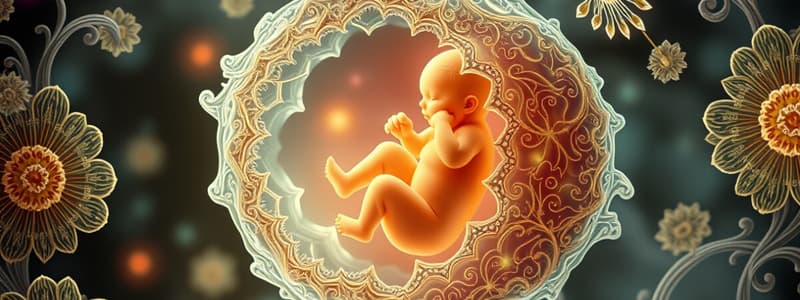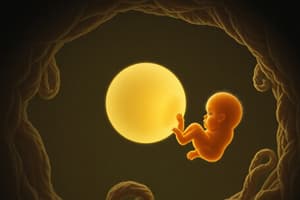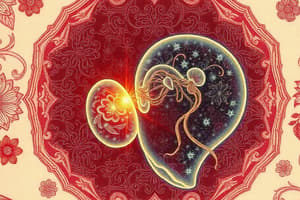Podcast
Questions and Answers
What are the two layers of the trophoblast during Day 8 of development?
What are the two layers of the trophoblast during Day 8 of development?
- Cytotrophoblast and syncytiotrophoblast (correct)
- Hypoblast and epiblast
- Mononucleated cells and bilaminar disc
- Inner cell mass and outer cell mass
Which structure is adjacent to the amniotic cavity during the second week of development?
Which structure is adjacent to the amniotic cavity during the second week of development?
- Trophoblast
- Hypoblast
- Syncytiotrophoblast
- Epiblast (correct)
What happens to the embryoblast at the beginning of the second week?
What happens to the embryoblast at the beginning of the second week?
- It becomes fully developed.
- It forms a trilaminar disc.
- It embeds deeper in the endometrial stroma.
- It differentiates into two layers. (correct)
What structure is formed by the coupling of the hypoblast and epiblast?
What structure is formed by the coupling of the hypoblast and epiblast?
What is true about the amnioblast during the second week of development?
What is true about the amnioblast during the second week of development?
On which day does the blastocyst become partially embedded in the endometrial stroma?
On which day does the blastocyst become partially embedded in the endometrial stroma?
Which layer of the trophoblast has distinct cell boundaries?
Which layer of the trophoblast has distinct cell boundaries?
What structure appears as a small cleft during the second week of development?
What structure appears as a small cleft during the second week of development?
What occurs after the sperm penetrates the zona pellucida?
What occurs after the sperm penetrates the zona pellucida?
What is restored to the diploid number during fertilization?
What is restored to the diploid number during fertilization?
What is formed immediately after the sperm penetrates the oocyte membrane?
What is formed immediately after the sperm penetrates the oocyte membrane?
How does the determination of sexual characteristics occur during fertilization?
How does the determination of sexual characteristics occur during fertilization?
Which stage follows the determination of sexuality and restoration of the diploid number?
Which stage follows the determination of sexuality and restoration of the diploid number?
What role do proteins and enzymes released by the zona pellucida play?
What role do proteins and enzymes released by the zona pellucida play?
What differentiates in the oocyte after sperm penetration?
What differentiates in the oocyte after sperm penetration?
What is a key characteristic of the zona pellucida during fertilization?
What is a key characteristic of the zona pellucida during fertilization?
What is the primary function of fimbriae in the reproductive system?
What is the primary function of fimbriae in the reproductive system?
At what stage of development is the blastomere formed?
At what stage of development is the blastomere formed?
What happens to the zona pellucida during early embryonic development?
What happens to the zona pellucida during early embryonic development?
What role does human chorionic gonadotropin (Hcg) play during early embryonic development?
What role does human chorionic gonadotropin (Hcg) play during early embryonic development?
At approximately how many hours post-fertilization does the four-cell stage occur?
At approximately how many hours post-fertilization does the four-cell stage occur?
Which hormone is primarily responsible for preparing the endometrium for implantation?
Which hormone is primarily responsible for preparing the endometrium for implantation?
What signifies the transition from the morula stage to the blastocyst stage?
What signifies the transition from the morula stage to the blastocyst stage?
What is the significance of the inner cell mass in embryonic development?
What is the significance of the inner cell mass in embryonic development?
What occurs to the corpus luteum if fertilization does not take place?
What occurs to the corpus luteum if fertilization does not take place?
At what stage does the human blastocyst begin to penetrate the uterine mucosa?
At what stage does the human blastocyst begin to penetrate the uterine mucosa?
Which layer of the endometrium has its own blood vessels and will degenerate if pregnancy does not occur?
Which layer of the endometrium has its own blood vessels and will degenerate if pregnancy does not occur?
What are the components of the blastocyst represented in the content?
What are the components of the blastocyst represented in the content?
If conception occurs, what changes happen to the corpus luteum?
If conception occurs, what changes happen to the corpus luteum?
What happens to the compact and spongy layers of the endometrium during the secretory phase?
What happens to the compact and spongy layers of the endometrium during the secretory phase?
What structure will become the future placenta during early development?
What structure will become the future placenta during early development?
What is one of the first noticeable changes in the second week of development?
What is one of the first noticeable changes in the second week of development?
What hormone is primarily responsible for triggering ovulation?
What hormone is primarily responsible for triggering ovulation?
Which substance levels remain high if fertilization occurs?
Which substance levels remain high if fertilization occurs?
Which phase of the menstrual cycle is characterized by high levels of FSH and the growth of ovarian follicles?
Which phase of the menstrual cycle is characterized by high levels of FSH and the growth of ovarian follicles?
What happens if a female is not ovulating based on LH levels?
What happens if a female is not ovulating based on LH levels?
When does progesterone begin to rise in the menstrual cycle?
When does progesterone begin to rise in the menstrual cycle?
What is the primary role of Clomiphene in female fertility treatment?
What is the primary role of Clomiphene in female fertility treatment?
Which day of the menstrual cycle is typically associated with ovulation?
Which day of the menstrual cycle is typically associated with ovulation?
What is the main function of the endometrial cycle?
What is the main function of the endometrial cycle?
Flashcards are hidden until you start studying
Study Notes
2nd Week of Development
- On Day 8, the blastocyst is partially embedded in the endometrial stroma.
- Trophoblast differentiates into two layers: cytotrophoblast (inner) and syncytiotrophoblast (outer).
- The embryoblast of the inner cell mass develops into two layers: hypoblast (adjacent to blastocyst) and epiblast (adjacent to amniotic cavity).
- The combination of epiblast and hypoblast forms the bilaminar disc and marks the beginning of the amniotic cavity.
- Events on Day 9 include the penetration of the corona radiata and subsequent penetration of the zona pellucida by sperm, leading to fertilization.
- After fertilization, secondary meiotic division occurs within the oocyte, resulting in male and female protocytes.
- Fertilization restores the diploid number of chromosomes (46) and determines genetic sex (XY for males, XX for females).
- Cleavage begins with the formation of two cells, progressing to four, then 16 (blastomeres), eventually forming a morula within the zona pellucida.
- The morula transforms into a blastocyst, comprised of an inner cell mass (future embryoblast) and an outer layer (trophoblast, future placenta).
- The blastocyst begins to embed into the endometrium, indicating the transition from the first to the second week of development.
- Human chorionic gonadotropin (hCG) is produced by the developing blastocyst to maintain progesterone production from the corpus luteum, crucial for implantation preparation.
- The menstrual cycle includes three phases: follicular phase, luteal phase, and menstrual phase; each regulated by various hormones including FSH, LH, and estrogen.
- During the follicular phase, FSH stimulates follicle growth and endometrial preparation, leading to ovulation on Day 14, marked by a spike in LH.
- If pregnancy does not occur, the corpus luteum degenerates, triggering menstrual cycle initiation by affecting the endometrial layers.
- Conception may influence future menstrual cycles, maintaining high progesterone and hCG levels to support the pregnancy.
Test Yourself Questions
- What is noticeable in the 2nd week of development?
- What two cavities are formed from mesoderm?
Studying That Suits You
Use AI to generate personalized quizzes and flashcards to suit your learning preferences.




